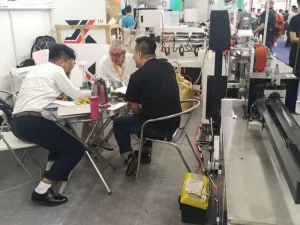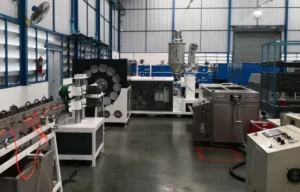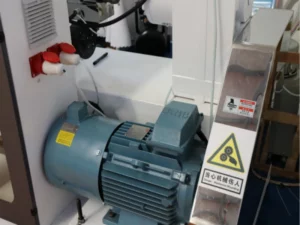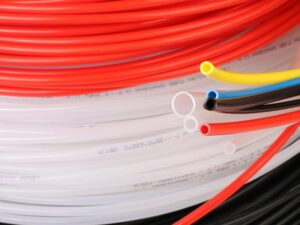
What is plastic extrusion? Plastic extrusion is a fundamental process in modern manufacturing, playing a crucial role in producing a wide range of plastic products that we use daily. This powerful process allows manufacturers to create items with consistent quality, high efficiency, and minimal waste. In this article, we will delve into what plastic extrusion is, understand the process, explore the materials used, discuss the advantages, and look at its various applications.
What is Plastic Extrusion?
At its core, plastic extrusion is a high-volume manufacturing process in which raw plastic is melted and formed into a continuous profile. This process is fundamental in creating objects with fixed, uniform cross-sectional areas. The versatility of extrusion allows for a vast array of shapes and sizes, making it a preferred method in plastic manufacturing.
Understanding What is Plastic Extrusion
What is plastic extrusion? Plastic extrusion is a manufacturing process where raw plastic material is melted and formed into a continuous profile. This process is used to create a variety of products, including pipes, tubing, sheets, and profiles. The history of plastic extrusion dates back to the early 19th century, but it has evolved significantly with advancements in technology and materials.
At its core, plastic extrusion involves forcing molten plastic through a shaped die to create a specific form. The process is highly efficient and can produce large quantities of uniform products, making it ideal for high-volume manufacturing.
The Plastic Extrusion Process
The plastic extrusion process can be broken down into several key steps:
- Melting the Plastic Material: The process begins with feeding raw plastic pellets, also known as resin, into an extruder. The extruder consists of a heated barrel and a rotating screw. As the screw turns, it pushes the plastic pellets forward through the barrel, where they are gradually heated to their melting point.
- Forcing Through a Die: Once the plastic is molten, it is forced through a die, which shapes the material into the desired profile. The die is a critical component of the extrusion process as it determines the final shape and size of the product.
- Cooling and Solidifying: After the plastic exits the die, it needs to be cooled and solidified to retain its shape. This is typically done using a series of cooling rollers or a water bath. The cooling process must be carefully controlled to prevent any deformation or defects in the final product.
There are different types of plastic extruders, the most common being single-screw and twin-screw extruders. Single-screw extruders are typically used for simple, high-volume production, while twin-screw extruders offer greater flexibility and control, making them suitable for more complex applications.
- Single Screw Extruder: Characterized by its simplicity and efficiency, the single screw extruder is widely used for processing a broad spectrum of materials. Its ease of operation and maintenance make it a popular choice in the industry.
- Twin Screw Extruder: Known for its superior mixing and shearing capabilities, the twin screw extruder is ideal for more complex tasks such as compounding, blending, and processing materials that require high levels of precision and control.
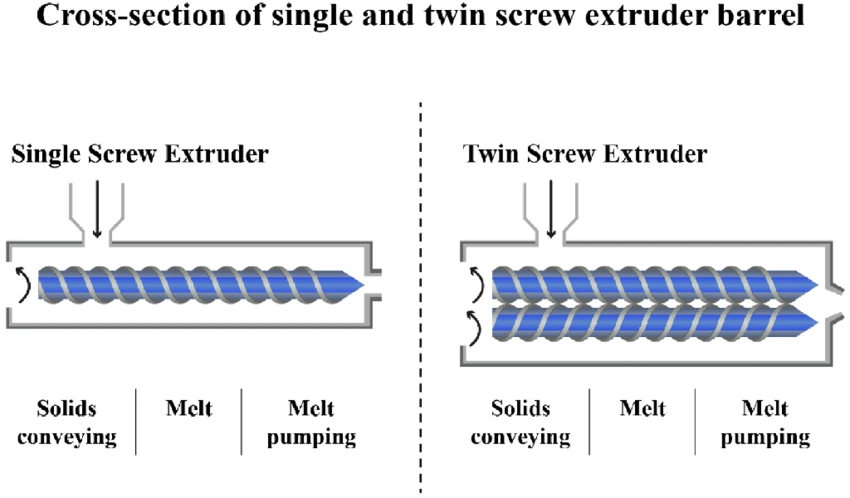
What Materials are Used in Plastic Extrusion?
What is plastic extrusion without the right materials? Various types of plastic materials can be used in the extrusion process, each with unique properties that make them suitable for different applications. Some of the most commonly used plastics include:
- PVC (Polyvinyl Chloride): Known for its durability and versatility, PVC is used in pipes, window frames, and various other products.
- PE (Polyethylene): PE is lightweight, strong, and resistant to moisture, making it ideal for packaging, piping, and household items.
- PP (Polypropylene): PP is known for its toughness and resistance to chemical and heat, commonly used in automotive parts, textiles, and reusable containers.
The choice of material depends on the specific requirements of the product being manufactured, such as flexibility, strength, and resistance to environmental factors.
What are the Advantages of Plastic Extrusion?
Plastic extrusion offers several advantages that make it a preferred manufacturing process for many industries:
- High Efficiency and Low Waste: The continuous nature of the extrusion process allows for high production rates and minimal waste. Any excess material can often be recycled and reintroduced into the process.
- Flexibility in Shapes: Extrusion can produce a wide variety of shapes and sizes, from simple tubes to complex profiles, with consistent quality.
- Consistent Quality: The controlled process ensures that products have uniform dimensions and properties, which is crucial for applications where precision is key.
- Cost-Effective: The efficiency and minimal waste associated with extrusion make it a cost-effective method for producing large volumes of products.
What are the Applications of Plastic Extrusion?
What is plastic extrusion used for? Plastic extrusion is employed in a vast array of applications, spanning various industries. Some of the key applications include:
- Pipes and Tubing: Used in plumbing, irrigation, and industrial applications, extruded pipes and tubing are essential for fluid transport.
- Profiles and Sections: These are used in construction for window frames, door profiles, and various structural components.
- Films and Sheets: Extruded plastic films and sheets are used in packaging, agriculture, and automotive industries. They can be used for protective coverings, liners, and other applications requiring large, flat surfaces.
Specific examples of plastic extrusion products include multi-layer fiber-reinforced pressure hoses, garden hoses, shower hoses, and washing machine inlet hoses.
Innovations in Plastic Extrusion Technology
The field of plastic extrusion continues to evolve with advancements in technology. Recent innovations have focused on improving efficiency, precision, and sustainability. For example, new extruder designs and control systems have enhanced the ability to process complex materials and create intricate profiles.
Moreover, advancements in materials science have led to the development of new polymers with enhanced properties, such as increased strength, flexibility, and resistance to environmental factors. These innovations allow manufacturers to produce high-performance products that meet the stringent requirements of modern applications.
Conclusion
What is plastic extrusion? It is a powerful and versatile manufacturing process that plays a vital role in producing a wide range of products used in everyday life. By understanding what plastic extrusion is, how the process works, the materials used, its advantages, and various applications, we can appreciate the significance of this technology in modern manufacturing.
As technology continues to advance, the future of plastic extrusion looks promising, with ongoing innovations set to further enhance efficiency, quality, and sustainability. If you’re interested in learning more about specialized plastic extruder machines and how they can benefit your production line, don’t hesitate to contact us for reliable, custom solutions tailored to your needs.
REFERENCES:
- Harper, C. A. (2006). Handbook of Plastic Processes. John Wiley & Sons. ISBN: 978-0-471-66255-6.
- Strong, A. B. (2006). Plastics: Materials and Processing (3rd ed.). Pearson Prentice Hall. ISBN: 978-0-13-114558-0.
- Rosato, D. V., & Rosato, D. V. (2000). Injection Molding Handbook (3rd ed.). Springer. ISBN: 978-0-412-99381-1.
- Osswald, T. A., & Hernandez-Ortiz, J. P. (2006). Polymer Processing: Modeling and Simulation. Hanser Publications. ISBN: 978-1-56990-398-8.
- Tadmor, Z., & Gogos, C. G. (2006). Principles of Polymer Processing (2nd ed.). Wiley-Interscience. ISBN: 978-0-471-38768-8.
- Crawford, R. J., & Martin, P. J. (2020). Plastics Engineering (4th ed.). Butterworth-Heinemann. ISBN: 978-0-08-102501-2.
- Goodship, V. (2016). Introduction to Plastics Recycling (3rd ed.). Smithers Rapra Technology. ISBN: 978-1-91024-234-7.
- Brydson, J. A. (1999). Plastics Materials (7th ed.). Butterworth-Heinemann. ISBN: 978-0-75063-439-7.
- Mark, J. E. (1999). Polymer Data Handbook. Oxford University Press. ISBN: 978-0-19-518101-2.
- Singh, R. (2012). Introduction to Basic Manufacturing Processes and Workshop Technology. New Age International Publishers. ISBN: 978-81-224-3071-4.
Tags:
Extrusion Process (1) PA Extrusion (1) Plastic Extruders (3) Reinforced Hose (2) Success Projects (1) TPE Extrusion (1) Troubleshooting (1)
